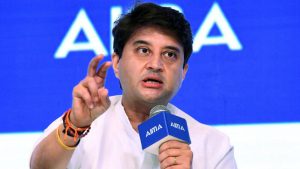Jyotiraditya M. Scindia, Minister of Civil Aviation talked about how Indian Aviation inched back to form post covid and how it now will be the backbone of Indian transportation both because of its physical reach and its cost-effective economic rates, at AIMA’s 66th Foundation Day.
Aviation was one of the most affected sectors during the pandemic, yet the services it provided to the people during that time have been admirable. The Civil Aviation Ministry remained unmovable during the very difficult time and has played a major role in the transportation of logistics in the country.
Last fiscal, the domestic passenger traffic at Indian airports was down by 62% and the international passenger traffic was down by 85%. Private aviation companies struggled to survive and the government lost thousands of crores.
So what was the plan executed to revive the industry and bring back the passenger traffic to the pre-covid levels?
Jyotiraditya M. Scindia said that Aviation was the sector hardest hit by the pandemic. It almost came to a standstill. He further added that in the 1st wave, passenger traffic went down from close to about 144 million unique passengers per year to zero. And then post the 2nd wave, it started inching its way back.
He mentioned how capacity caps and fare caps were put in place to give a little bit of an insulated environment in which the industry could function, to ensure that all the players survive, and all of them get some decent market share and some levels of revenue. From July till October last year, the sector sequentially raised capacity from 50-62% to 75 to 82% and opened up full capacity on the 18th of October to 100%. Pre-covid numbers were close to about 4 lakh passengers per day, and in November and December, the sector hit numbers close to 3.8 to 3.9 lakh per day. The numbers were back to pre-covid levels, roughly 3 to 4% off pre-covid levels, and that only talked about the bouncy of the sector.
When the omicron wave came along, there was again a decline in the number of passenger traffic. There was a contraction of 65-70%. In physics terms, the amplitude was high but the wavelength was equally narrow. However, Jyotiraditya M. Scindia predicted that the passenger traffic would cross pre-covid levels, which would also herald new demand and new capacity coming in. There would also be the rebirth of Jet Airways and a new airline, Akasa Air operational.
When we talk of infrastructure, it is not just airports, there are highway connections to the airport, also Hospitality and Tourism that work very closely with Aviation. So how did Aviation in combination with tourism and hospitality work for boosting the economy as well as reviving jobs that were lost during the pandemic?
Jyotiraditya M. Scindia said that though Railways have deep penetration in the country, people are still looking to save time hence resort or Air Travel, which has led to a demand for Airline Connectivity. In terms of economic output multiply, Civil Aviation is close to 3.25%
The employment multiply from Aviation alone is close to 6.1%, which translates to; if Civil Aviation creates a direct job, it creates 6.1 indirect jobs. Civil Aviation is an important part of a country’s economic growth paradigm. That is the reason the PM has laid emphasis on the sector in terms of the Udaan Programme where rural and urban connectivity is subsidised through the Programme. Hence 65 new airports and heliports are operational along with the creation of 400+ new routes. Besides, the contemplated and anticipated Prati Shakti Programme will create infrastructure connectivity like never before, which will render a huge payback for the economy.
Since Aviation has been creating routes for flying drones and the government has also included drones under its PLI Scheme. So when could drones do routine tasks and how would drones change the Aviation landscape? Answering the question, Jyotiraditya M. Scindia said that every 5-10 years the world witnesses a tectonic disruption, earlier there was a cell phone disruption, likewise, drone technology is also going to be a positive disruptive paradigm. There are a number of value chains involved in drone operations. The first part of the value chain is Production. The 2nd part will be Service Delivery. The 3rd part of the value chain is Employment Opportunity. If all of these fall into place, then India can become the drone hub by 2030.
Considering all the things happening on the Aviation front, Jyotiraditya M. Scindia concluded that Civil Aviation is going to become the backbone of Indian transportation over the next 5 to 10 years, both because of its physical reach as well as its cost-effective economic rates. “I firmly believe that the Civil Aviation’s story in India is extremely strong,” he said.
Watch full session here- https://www.youtube.com/watch?v=YjXZRsB2B9I



